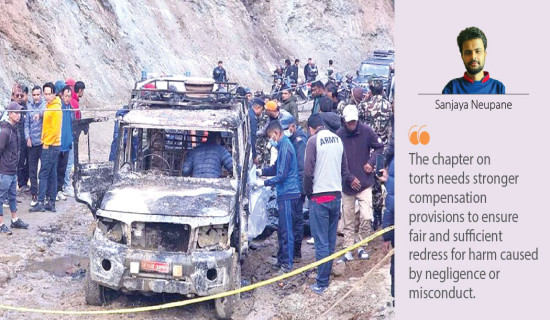- Saturday, 3 May 2025
Professional Indemnity For Hospitals
Dr. Rama Dahal / Dr. Avinash Chandra
Many a times we have heard of patient being admitted for one specific cause and over a period of time develops multiple other problems during his stay at the hospital and eventually passes away. In most cases the patient family would not even be aware of the fact why the list of medicines begins to increase when they are counting days to return home after recovery. Worst is a case when the patient is in ICU, the nurse would call an attendant to bring the supplies and nothing more to tell; and in several instances even when the doctor explain the situation, it is full of uncertainties and difficult to appreciate things that the medicos are saying or doing.
Doctors' Negligence
A very unpleasant development is taking place with patient kin accusing the treating doctors and hospitals for their negligence that lead to patient’s death. The culprit may not always be the doctors. There are instances of high numbers of unavoidable hospital acquired infections in the ICUs of our country’s hospitals. There are leading causes of deaths in hospitals globally as well, and we have not known that hospital acquired infections are the cause. The cause of death when asked would be “Multiple Organ Failure.”
Depending on the age and condition of the patient admitted, it is contracted by one fourth of all patients admitted in ICUs (Ref India). More alarming is the claim that half of those who contract the infection inside ICU ultimately lose their battle with this deadly disease that induces massive organ failure. Interestingly the same study reveals that the major causes of the infection are poor hospital hygiene and misuse of antibiotics. We are unable to find accurate data of such cases in our context.
With increase in awareness level and the general economic improvement in the life of urban Nepalese; it has changed the traditional doctor-patient relationship. There is an Increasing risk of Professional Indemnity liability in Hospitals. According to a newspaper report, the average number of cases that has captured the headlines related to medical negligence and malpractice has been at a rise in the recent years.
Hospitals and medical practitioners are not only being questioned and challenged by those dependent on their skills but are also held accountable for their actions with consequences that can be extremely frustrating both professionally and financially. We have several occurrences that has made the news (Source: Nepali Times 3-9Th March 2017, Cashing in on tragedy by Sonia Awale) - A 29-year-old patient was operated on for appendicitis at Bijaypur Hospital in Dharan last week. The surgery went well, but the patient choked on food and died during recovery. Angry relatives mobilised a crowd and vandalised the hospital. The matter was resolved only after the hospital agreed to pay compensation if an investigation proved negligence.
In September 2015, a two-year old infant suffering from abdominal pain and vomiting died after being admitted to a government hospital in Charikot. Rowdy political cadres and hoodlums entered the hospital and abused medical personnel, posting humiliating pictures of a doctor begging for mercy on YouTube. Family members refused to take the baby’s body.
A young man in his early 40s was admitted for minor surgery at Patan Hospital, but in post-op he was over-sedated by relatives. Combined with a pre-existing sleep apnoea condition, the patient died. A large crowd formed inside the hospital demanding compensation, and the relatives refused to take the body unless the hospital paid compensation. The case was settled after the treatment fee was waived, and the widow was offered a job.
A patient was operated for the Septoplasty (correction of deviated nose wall) at Om hospital. The operative procedure is considered as one of the simplest one. However, the patient died post operatively and the doctor who had performed surgery was humiliated by the mob and the hospital was vandalised only to settle with some monetary compensation.
Such situations deplete the moral and confidence of the doctors and the medical practioners. Their image gets ruined and public tend to lose faith in them without even trying to understand the real cause. We cannot deny that a day will come when the cases would be filed in court against the hospital or the treating doctors.
Traditionally, such cases are covered by the hospital management by waving the expense for the patient, however the other way would be to insure under Professional Indemnity Insurance (PI). This insurance covers legal liability arising from errors and omissions on the part of Registered Medical Practitioners while rendering professional service.

The policy is meant for professionals
Doctors and me dical practitioners - which covers registered medical practitioners like general practitioners, physicians, surgeons, cardiologists, pathologists etc.
Medical establishments - which covers legal liability falling on the medical establishment such as hospitals and nursing homes, as a result of error or omission committed by any named professional or qualified assistants engaged by the medical establishment.
It applies to claims arising out of bodily injury and/or death of any patient caused by or alleged to have been caused by error, omission or negligence in professional service rendered or which should have been rendered by the insured. PI also pays for the cost incurred in defending the case.
Paying Damages
The policy covers all sums that the insured professional becomes legally liable to pay as damages to third party in respect of any error and/or omission on his/her part committed whilst rendering professional service. Legal cost and expenses incurred in defense of the case, with the prior consent of the insurance company, are also payable, subject to the overall limit of indemnity selected. Only civil liability claims are covered. Any liability arising out of any criminal act or act committed in violation of any law or ordinance is not covered.
In Professional Indemnity Policy, the sum insured is referred to as Limit of Indemnity. This limit is fixed per accident and per policy period which is called Any One Accident (AOA) limit and Any One Year (AOY) limit respectively. The ratio of AOA limit to AOY limit can be chosen as 1:1,1:2,1:3,1:4.
The AOA limit, which is the maximum amount payable for each accident, should be fixed taking into account the nature of activity of the insured and the maximum number of people who could be affected and maximum property damage that could occur, in the worst possible accident. In case of a low value insurance it can lead to a dangerous situation where the hospitals may not get the recoveries that they need to compensate from the insurance company.
The term "liability" means responsibility and "legal liability" means responsibilities which can be enforced by law. Legal Liability may be classified into Criminal Liability and Civil Liability. Only Civil Liability claims are payable.
Civil Liability claims will arise if there is prima facie evidence of negligence by the insured resulting in injury or death to any third party or resulting in damage to property belonging to a person other than insured.
Negligence will be proved only when following conditions are satisfied: a) existence of duty of care b) Breach of this duty, and c) Injury suffered by a person or property damaged as a result of that breach.
In case of any event likely to give rise to a liability claim as described above, insurance company should be informed immediately. In case any legal notice or summons is received, it should be sent to the insurance company.
The event giving rise to the claim should have occurred during the period of insurance or retroactive period (in case of continuous renewal of the policy) and the claim first made in writing against the insured during the policy period. The maximum amount payable including defense cost will be the AOA limit selected. The Any One Year limit will get reduced by the amount of claim or indemnity paid for any one accident. Any number of such claims made during the policy period will be covered subject to the total indemnity not exceeding the Any One Year limit.
However, the policy will not pay for claims arising out of contractual liability, intentional non-compliance of any statutory provision, loss of goodwill, slander, fines, penalties, libel false arrest, defamation, mental injury etc.
A Thin Line
The PI policy treads a thin line when dealing with negligence on the part of the insured, in this case the hospital or the doctor. It covers for negligence but states that if the insured is guilty of willful negligence the claim will not be reimbursed. Any non- compliance with laid down norms or generally accepted industry practices can be construed as willful negligence. Any cost cutting by the hospital that can be linked to reduction in patient safety can be termed as willful negligence.
Thirdly, the insurance policy demands that the insured party continues to behave as if “not insured”, to eliminate the benefit of the doubt of mala fide intentions. With changing socio-economic profile of patients and their families, it becomes important for the hospitals and health professionals to review their risk periodically.
The information mentioned above for PI policies are indicative, not exhaustive. It is better to contact the insurance company to understand the covers, exclusions and the procedures to be followed for better understanding.
(Dr. Rama Dahal is a Chartered Insurance Practitioner Dahal.rama@gmail.com and Dr. Avinash Chandra is a Neurologist chandraavi@gmail.com)

















